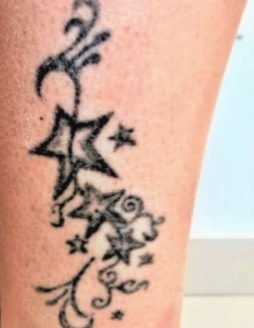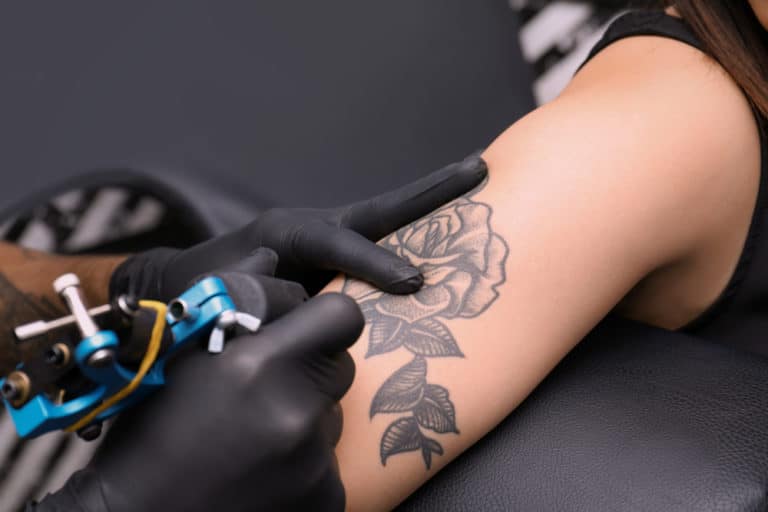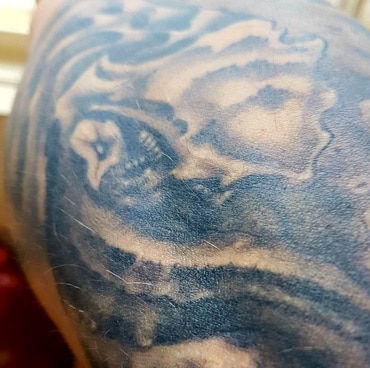Are Old Tattoos Harder To Remove? With Examples!
People get tattoos for many reasons. Some are symbolic. Some are done in the spur of the moment or to send a message. Whatever your reason for getting one is, a common question people new to tattoos have is whether or not it can be effectively removed afterward, especially after having second thoughts about it a couple of years later.
Older tattoos are not harder to remove. The older they become, the easier it is to remove them entirely. A brand new tattoo might require as many as 15 treatments to remove, whereas a tattoo older than ten years might only take 4 – 6 treatments to eliminate.
With recent advancements in tattoo removal technology and methods, it’s easier than ever to get rid of your unwanted ink. Before you book your first appointment, consider the following. It will save you time, money, and pain.

Why Older Tattoos Are Easier To Remove Than Newer Tattoos
It’s been a few years, and your life has changed significantly, and you’re looking at some of your tattoos and can’t seem to remember why you got them in the first place. The color faded along with the meaning a long time ago. These tattoos are the ideal candidates to get removed.
Older tattoos have faded and have lost some of their structural integrity over time, which aids in the removal process. Tattoos degrade and become easier to remove for two main reasons.
- Sun Exposure. The dermis is the second layer underneath your skin and is relatively thick. Tattoo artists put ink in this layer because it makes your tattoo last longer. However, this doesn’t stop the sun’s UVA rays or otherwise known as ‘aging rays’, from penetrating through the epidermis and slowly break down the ink particles over time.
Your immune system slowly takes over and carries away the broken ink pigments that have been shattered by the sun’s burning rays causing them to fade. In some instances, prolonged exposure to UVA rays could change some pigments’ color, causing them to turn green or blue. A faded tattoo is much easier to remove because there is less ink. - Body Rejection. Your body sees tattoo ink as a foreign object and will do what it can to get rid of it, but it cannot remove it entirely. When you get a new tattoo, your body signals white blood cells to attack the intruding pigment, much like it would strike a virus or bacteria. Your body also deploys what immunologists call adaptive responses. This collection of proteins in the blood are called antibodies. They constantly circulate the bloodstream looking for anything it deems intrusive. Over many years your immune system will wear down your tattoo and, in turn, make it easier for the technician to remove what’s left.
11 Tattoo Removal Factors
Tattoos older than ten years are much easier to remove. However, the tattoo’s age isn’t the only factor to consider when removing it. The process of removing an old tattoo takes time, but the efficacy of the removal process can be affected by various influences such as:
- Skin tone. Tattoos are made to last a lifetime. They survive this long because the ink is placed in the second layer of skin known as the dermis. The dermis’ function is to protect the first layer of skin from the harsh elements of nature.
Your skin tone can affect the time it takes for the laser to penetrate the dermis to break up the tattoo. The reason for this is because the laser requires a higher wavelength, which in turn causes less damage but is less effective. - Ink quality/ink types. Tattoo inks vary in both quality and composition. Inks could be as unique as the tattoo itself. Some artists prefer pre-made inks, also known as pre-dispersed inks, while others might mix their pigment and carrier. Some ink might include beryllium, which is known to be harder to remove via laser treatment.
- Tattoo location. The closer your tattoo is placed to your heart, the quicker your immune system will remove the broken pieces post-procedure. The further away the tattoo is, the longer it will take for the blood to circulate to that area.
- Aftercare. In the process of getting your tattoo, you damage the epidermis of your skin. A good quality tattoo from a professional tattoo artist usually heals well, but a lower quality tattoo from a lesser skilled artist might heal slower and leave scar tissue. This scar tissue is a lot harder to remove than regular skin.
- Size of the tattoo. The more ink, the longer it takes. A large tattoo like a full sleeve will take significantly longer than a small, simple tattoo.
- Ink colors. Black tattoos are the easiest to target since the laser system targets high-contrast pigments more precisely. Brown, dark blue, green, and purple are also easier to remove than other colors. White is almost impossible to extract. If the laser hits the white pigment, it often turns grey, which lengthens the removal process. Light colors, including yellow and orange, are very reflective, which causes the laser to bounce off of it instead of penetrating it. A special laser is required to remove lighter colors.
- Ink Depth. Professional tattoo artists often penetrate deep into the dermis with more ink for the tattoo to stay brighter and last longer. The deeper the ink is, the more difficult it is to remove.
- Immune System. The laser only breaks up the tattoo. Your immune system does the rest. A healthy immune system produces Macrophages, which destroys foreign bodies, including ink. Make sure you maintain a robust immune system for optimal results.
- Smoking. Smoking is known to affect the function of cells in your body. Studies have shown that smokers have lower circulation and less effective immune systems compared to non-smokers. This decrease causes the healing time in between sessions to increase.
- Cover-ups. Adding more ink on top of an existing tattoo increases the amount of pigment under the skin, which increases the amount of time it will take to remove the tattoo.
- Type of laser. Traditional Q-Switched lasers are the most common. They use heat to break the tattoo into smaller pieces and take around ten to twenty sessions. The new PicoSure laser shatters the ink into smaller particles and can be up to 75% quicker than traditional lasers.
The 3 Most Common Risks And Side Effects Of Tattoo Removals
Removing old tattoos carry the same risks as removing newer tattoos, no matter the age of your tattoo. If these factors pertain to you, you should speak to your consultant before starting the treatment procedure.
- Darker skin. Tattoo removal lasers function better with higher contrast. If you have darker skin, some tattoo remnants might still be visible after all your sessions have been completed.
- Pre-existing Skin Conditions. Skin conditions like Eczema and Psoriasis could hinder your tattoo removal journey and increase the number of sessions it might take to eradicate your tattoo.
- Pre-existing Health Conditions. Suppose you have a history of cold sore or suffer from other forms of herpes. In that case, you have to take prophylactic anti-herpes medication before starting the tattoo removal process to allow for a faster recovery time.
Why Laser Treatment Is The Best Tattoo Removal Option
Experts can all agree that the most successful and cost-effective method to getting a tattoo removed is via a laser. This procedure uses concentrated bursts of light to break up the ink underneath your skin into smaller pieces, which then allows your body’s immune system to destroy the left-over bits of ink. Laser tattoo removal could take anywhere from four to six treatments and costs anywhere between $200 and $500 per treatment session.
How Long Should I Wait Before Getting My Tattoo Removed?
Medical professionals recommend a minimum waiting period of four to six weeks before starting the tattoo removal process after getting a new tattoo. This waiting period ensures that the tattoo is completely healed before treatment starts. If you do not allow for the healing process to complete before starting the removal process, it could lead to unwanted scarring and painful blisters.
Alternative Tattoo Removal Options
- Surgical removal. This procedure involves a plastic surgeon who uses a scalpel to cut away the tattooed skin. Surgical removal is a very effective alternative method and is often less expensive. Keep in mind that it will leave a scar and should only be used for small tattoos.
- Dermabrasion. Removes a layer of skin with a sanding device, which allows the ink to leach out., this method is not suggested if you have sensitive skin or suffer from skin conditions like Eczema.
If you are looking for inspiration, check out my portfolio – you can find my works and projects here – on Instagram.
Conclusion
Tattoos are much easier to remove today than they were ten years ago, especially if you have an older tattoo. Thanks to tattoo removal technology innovations, it takes less time, effort, and money to remove it successfully.
If you want to remove a tattoo, it’s better to wait a while to let your body break it down slowly over time. The older your tattoo gets, the better your chances become of removing it entirely with minimum risks of lasting side-effects.
Removing a tattoo takes time, and you need patience and perseverance to do it. Before booking your first treatment, be sure to consult your doctor to ensure that it is safe and make an informed decision on which route to take to get the desired outcome without breaking the bank.






